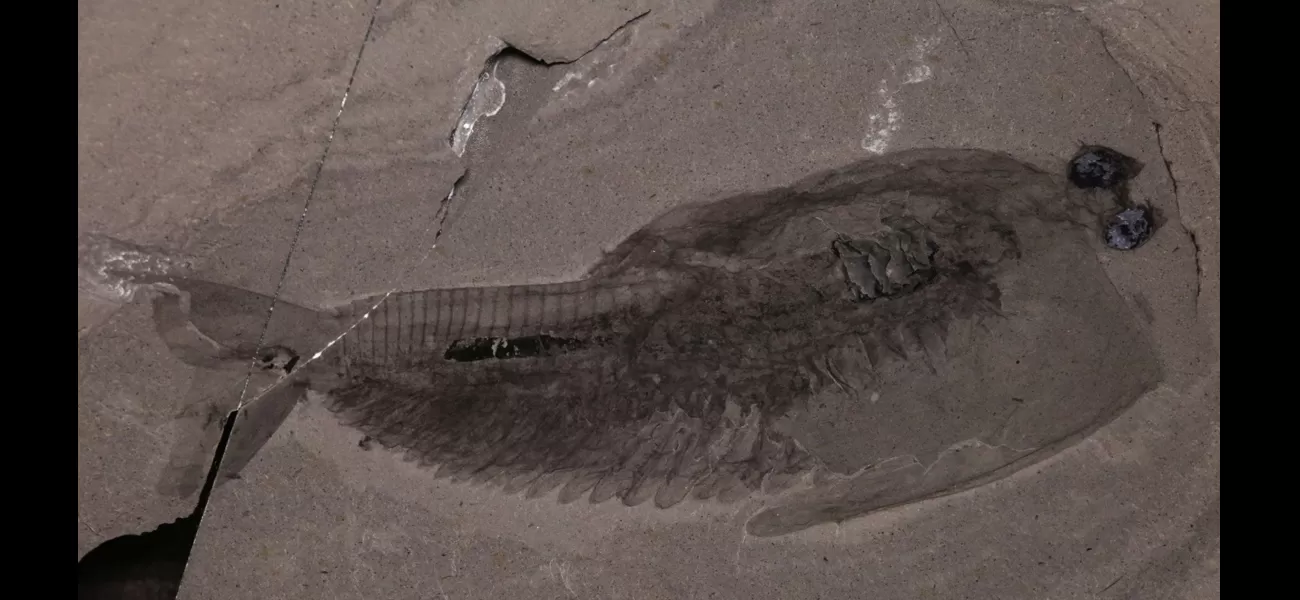After 500 million years, the mystery of the fossilized 'alien fish taco' has finally been solved.
Studying ancient animal appearance and behavior can reveal reasons for their success over 500 million years.
August 7th 2024.

After years of puzzling over this strange sea creature, scientists have finally unraveled the mystery behind its peculiar appearance. Dubbed the "alien fish taco", the Odaraia has captured the curiosity of many with its large eyes, taco-shaped shell, and tail resembling a submarine's rudder. But a recent study led by evolutionary biologist Alejandro Izquierdo-López has shed light on the bizarre biology of this ancient creature.
The Odaraia, believed to have roamed the oceans around 500 million years ago, is an arthropod - a type of animal similar to crabs and shrimp. It boasts a pair of large eyes, two "jaws" on its mouth, and a long body with almost 30 pairs of legs. The most striking feature, however, is its tail, which closely resembles the rudder of a submarine or the tail of a shark. This, along with its shield-like carapace that covers half of its body, has earned it the nickname "fish taco".
But what sets the Odaraia apart from other arthropods is the recent discovery of two mandibles on its fossils. This has led scientists to classify the creature as a mandibulate, making it one of the earliest ancestors of the vast majority of animal species on Earth today. According to Alejandro, this classification is crucial in understanding the success of these animals and how they evolved over time.
The study was conducted by examining over 150 fossils collected from the Burgess Shale in British Columbia, Canada, between 1975 and 2000. This ancient fossil site has been a treasure trove for paleontologists, with the first Odaraia fossil being unearthed in the 1910s. It is thanks to the meticulous research of Alejandro and his co-author, palaeontologist Jean-Bernard Caron, that the enigmatic classification of this creature has been finally solved.
So, what exactly was the Odaraia's lifestyle like? Alejandro believes it was a skilled hunter, using its large eyes to detect small prey and its 30 spiny legs to capture them as they passed over its "taco" shell. The legs would then bring the food to its mouth, where the mandibles would break it apart. This behavior, paired with its ability to swim across the water column rather than being stuck to the seafloor like other creatures of its time, may have contributed to its success in the tropical, shallow seas of the Burgess Shale.
The study, published in the journal Proceedings B, has not only solved the mystery of the Odaraia's classification but also provided valuable insights into the evolution and success of mandibulates. As we continue to uncover the secrets of the ancient world, this "alien fish taco" will no longer remain a bizarre enigma, but rather a fascinating piece in the puzzle of life on Earth.
The Odaraia, believed to have roamed the oceans around 500 million years ago, is an arthropod - a type of animal similar to crabs and shrimp. It boasts a pair of large eyes, two "jaws" on its mouth, and a long body with almost 30 pairs of legs. The most striking feature, however, is its tail, which closely resembles the rudder of a submarine or the tail of a shark. This, along with its shield-like carapace that covers half of its body, has earned it the nickname "fish taco".
But what sets the Odaraia apart from other arthropods is the recent discovery of two mandibles on its fossils. This has led scientists to classify the creature as a mandibulate, making it one of the earliest ancestors of the vast majority of animal species on Earth today. According to Alejandro, this classification is crucial in understanding the success of these animals and how they evolved over time.
The study was conducted by examining over 150 fossils collected from the Burgess Shale in British Columbia, Canada, between 1975 and 2000. This ancient fossil site has been a treasure trove for paleontologists, with the first Odaraia fossil being unearthed in the 1910s. It is thanks to the meticulous research of Alejandro and his co-author, palaeontologist Jean-Bernard Caron, that the enigmatic classification of this creature has been finally solved.
So, what exactly was the Odaraia's lifestyle like? Alejandro believes it was a skilled hunter, using its large eyes to detect small prey and its 30 spiny legs to capture them as they passed over its "taco" shell. The legs would then bring the food to its mouth, where the mandibles would break it apart. This behavior, paired with its ability to swim across the water column rather than being stuck to the seafloor like other creatures of its time, may have contributed to its success in the tropical, shallow seas of the Burgess Shale.
The study, published in the journal Proceedings B, has not only solved the mystery of the Odaraia's classification but also provided valuable insights into the evolution and success of mandibulates. As we continue to uncover the secrets of the ancient world, this "alien fish taco" will no longer remain a bizarre enigma, but rather a fascinating piece in the puzzle of life on Earth.
[This article has been trending online recently and has been generated with AI. Your feed is customized.]
[Generative AI is experimental.]
0
0
Submit Comment





